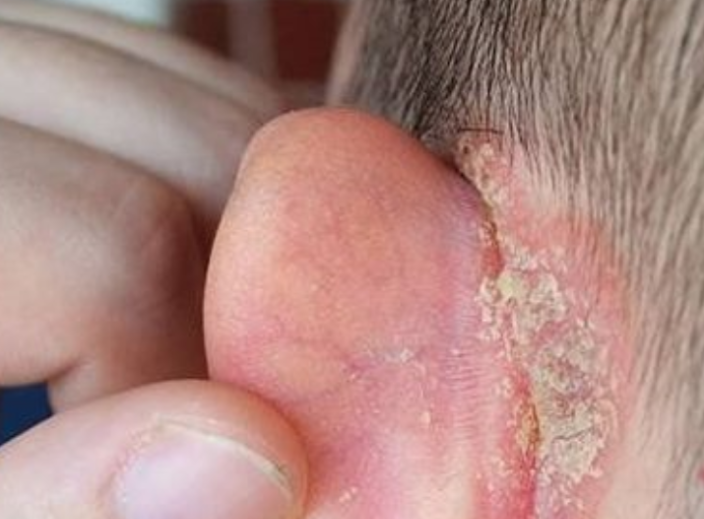After returning from a two-week work trip, I noticed an unusual blue tattoo on my dog Zuni’s stomach, which appeared during her stay at a 24/7 daycare. I posted about it in a local pet owners’ Facebook group, seeking answers before reaching out to the facility directly.
I shared the post with a photo of Zuni, my pit-lab mix, lying on her side, revealing a small, faded blue mark near her belly. The mark resembled a single-line shape—possibly a number or letter—and it definitely wasn’t there when I dropped her off at the daycare.
I spent several minutes examining the mark closely before snapping the picture.
I had been away at a training conference in Vancouver, enduring two weeks of meetings, late dinners, and jet lag. I missed Zuni terribly and had chosen a “luxury” 24/7 dog daycare called WagMore Acres, which boasted cameras, daily updates, and cheerful Instagram posts of happy dogs.
The check-in process went smoothly, and the staff appeared welcoming. When I picked Zuni up, she seemed fine—perhaps a bit tired, but her tail wagged, and she leaned against me before sleeping through the car ride home. It wasn’t until that evening, during a belly rub, that I discovered the blue mark.
Within an hour of my Facebook post, responses flooded in.
Group members suggested it might be a spay tattoo, a common marking to indicate a dog has been fixed, preventing unnecessary surgeries. Others noted that shelters often use such tattoos. This seemed plausible, except Zuni was already spayed when I adopted her two years earlier.
And I was certain she had no tattoo then.
That night, I emailed WagMore Acres and followed up with a phone call the next morning. A staff member named Carly answered, initially cheerful, but her tone shifted when I mentioned the tattoo.
She paused.
Then she said, “Oh, let me check with our shift manager. Can I call you back?”
I agreed.
An hour passed. Then three.
By midday, I called again, but no one answered.
A sense of unease began to settle in.
I decided to visit the daycare in person. It was a short fifteen-minute drive from my home, located behind a strip mall with a yoga studio and a vape shop. The building looked familiar—bright murals of cartoon dogs, artificial grass, and a sign proclaiming, “WagMore: Where Dogs Are Family!”
At the front desk, a new employee didn’t recognize me.
When I asked for Carly, she said Carly no longer worked there.
“She left last week,” the employee said, glancing nervously behind her. “It was sudden.”
I requested to speak with the owner or manager. After a brief hesitation, the employee disappeared into the back.
I waited nearly ten minutes.
A tall, pale man carrying a clipboard emerged, introduced himself as Jeff, and offered a strained smile.
I explained Zuni’s situation, showed him the photo, and emphasized that she was already spayed before her stay. He leaned in, studied the image, and said matter-of-factly, “That’s a spay tattoo. It’s standard. Some vets add them later.”
“But she was already spayed,” I said again.
He shrugged. “It might have been a precaution. We work with local vet clinics if there’s any uncertainty.”
“Uncertainty about what?” I pressed. “You weren’t authorized to perform any medical procedures without my permission.”
His demeanor changed. He became guarded, speaking vaguely about “standard protocols” and “misunderstandings.” He mentioned a general waiver I had signed, which included a clause about necessary veterinary procedures.
I demanded the name of the clinic they partnered with. He said he’d need to “check the system” and would email me the details.
I left without responding.
No email arrived.
That night, sleep eluded me. Questions swirled—what else had happened to Zuni? She seemed fine, but what if the daycare was hiding something?
The next morning, I took Zuni to our trusted veterinarian, Dr. Nguyen, who had cared for her since I adopted her. I showed him the tattoo, and he frowned before lifting Zuni onto the exam table.
He studied the mark closely.
“This is recent,” he said. “And not well done.”
I asked if it was a spay tattoo.
“It’s designed to resemble one,” he replied carefully. “But it’s not in the usual spot, and the ink is uneven. It looks like an amateur job.”
My heart sank.
He checked Zuni’s spay scar, confirming it was unchanged and that no new surgery had occurred.
“So they tattooed her,” I said. “To make it seem like she was spayed?”
“Or to conceal something else,” he said.
I felt nauseated.
Dr. Nguyen suggested bloodwork to rule out other issues. I consented.
The results were mostly normal, but one detail stood out.
Zuni’s microchip data had been altered.
The chip still functioned, but it now listed a new owner: Rachel Nevin.
I stared at the name on the printout, hoping it was a mistake.
I had never heard of Rachel Nevin.
Dr. Nguyen pulled up Zuni’s original microchip records, registered under my name and address. He explained that someone must have submitted forged documents to the chip registry to change the ownership.
The pieces began to fall into place.
The tattoo. The altered microchip. Carly’s sudden departure. Jeff’s evasive responses.
Someone at WagMore had attempted to claim Zuni as their own.
I contacted the microchip company immediately. After verifying my identity as the original owner, they froze the chip and flagged it for fraud. I asked how the information had been changed.
The representative explained, “Someone emailed scanned forms—photo ID, vet records, the standard requirements.”
I requested copies of the submitted documents.
They agreed, but only with legal authorization.
I reached out to my friend Junie, who works at a law firm. Though not a pet law expert, she drafted a formal request on my behalf.
Three days later, I received a ZIP folder containing the documents.
Opening them sent a chill through me.
The photo ID was blurry but bore the name Rachel Nevin, with an address in nearby Riverside. The vet records were largely fabricated, though some appeared to be scanned from Zuni’s actual file, suggesting someone at WagMore had access to her records.
On one form, I saw Carly’s signature in the corner.
She hadn’t quit—she was either fired or left after trying to steal my dog.
I updated the Facebook group with this information. Within an hour, a woman named Luisa sent me a direct message. She recognized the name Rachel Nevin—her friend’s dog had vanished after a stay at WagMore two months prior.
I asked for details. Luisa called me.
Her voice shook as she spoke.
“My friend Marta had a golden retriever named Miso. She left him at WagMore before visiting family in Mexico. When she returned, they said he escaped during an outdoor break—claimed he slipped his collar. But Marta always checked his harness, and he was microchipped.”
“What happened next?” I asked.
“They refunded her and sent a sympathy card. But she never found Miso. No shelter or vet had any record of him.”
I asked if Miso had a spay or neuter tattoo.
Luisa confirmed it was blue, on his belly.
I couldn’t sleep that night.
Fueled by coffee and determination, I began researching. I scoured property records, Yelp reviews, and LinkedIn profiles. Carly had been WagMore’s “intake coordinator” and previously volunteered at a shelter that closed due to mismanagement of animals.
I also discovered that WagMore wasn’t owned by Jeff but by an LLC tied to a man named Marcus Liddell. Further digging revealed troubling civil suits—lost dogs, sloppy record-keeping, and one case settled privately for an undisclosed sum.
The next day, I reported everything to animal control.
They took my complaint seriously, especially the microchip tampering, and opened an investigation.
More pet owners came forward over the next two weeks, sharing stories of strange behavior, unexplained injuries, and missing dogs. One owner had records showing her dog was neutered twice, according to conflicting documents.
Within a month, WagMore was shut down.
A local news outlet covered the story, calling it “A Betrayal of Trust at a Beloved Daycare.” It was dramatic but accurate.
Carly faced no formal charges due to insufficient evidence, but the investigation revealed she had been re-homing dogs to friends or contacts, claiming they were strays or abandoned. Marcus, the owner, was fined for negligence and barred from running pet-related businesses in the state.
Jeff, meanwhile, disappeared—likely onto his next venture.
Then, two months later, I received a handwritten letter from Riverside.
It was from Rachel Nevin, the name listed as Zuni’s false owner.
She wrote:
“I didn’t know Zuni was stolen. Carly told me she was surrendered by a family unable to keep her, and she provided adoption papers. I only had Zuni for four days before the microchip company flagged it as fraud. I’m deeply sorry for what happened.”
She included her phone number, offering to talk.
Initially, I wasn’t interested.
But a week later, curiosity won out.
I called Rachel. She was soft-spoken and remorseful. She had lost her own dog to cancer and was eager to adopt again. Carly had described Zuni as a dog who needed a calm home after being passed between owners.
“She was the sweetest dog I’ve ever met,” Rachel said, her voice breaking. “But I know she belongs to you.”
I paused.
Then I asked, “Was she okay with you?”
Rachel gave a small laugh. “More than okay. She slept on my feet and followed me everywhere.”
That night, I hugged Zuni a little tighter.
At first, I was consumed by anger and betrayal, wary of trusting anyone. But now, nearly a year later, watching Zuni nap on the couch, I feel a sense of perspective.
Perhaps Zuni’s experience helped uncover a larger issue.
And perhaps, for four days, she brought comfort to someone grieving.
Cherish your pets. Stay vigilant. Follow your instincts.
Even the most welcoming places may not always be safe.
Please like and share to support those who can’t advocate for themselves. 🐾






